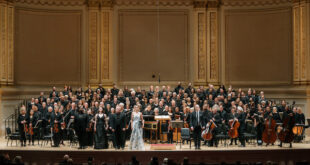The newly released DVD Ballads, Blues, and Bluegrass is a piece of Greenwich Village history unlike any I have ever seen. Back in 1961, Alan Lomax was approached by an English producer to film musicians for a proposed series. One night after a New York concert, Lomax invited some of the participants back to his apartment for the impromptu party that is captured here. Although the proposed series never materialized, the footage captured that night is an incredible snapshot of the period.
The black-and-white DVD begins with a short introduction from Mr. Lomax explaining what is to follow. We are then ushered inside the book-filled apartment for a performance by the New Lost City Ramblers. Their take on the traditional bluegrass “Foggy Mountain Top” is fantastic.
From there we get a taste of some topical music, in this case regarding the bomb. After a short interview, Ernie Marrs pulls out his guitar and begins singing “Plop Goes the Missile.” Another highlight follows this, with the appearance of a character by the name of Clarence Ashley. Accompanying him on guitar is a very young Doc Watson, who nobody really even knew about yet. Apparently this is the earliest known footage of Watson playing.
Ramblin’ Jack Elliot is also present, and his rendition of Woody Guthrie’s “Talking Sailor” offers a cogent reminder of why he was such a big part of the scene. Although all of the material on the DVD is pretty great, the biggest moment (for me at least) comes with the perfomance of Willie Dixon and Memphis Slim. The opening instrumental “Walkin’ the Boogie” finds Dixon bearing down hard on his upright bass, while Memphis Slim tickles the ivories. One of the amusing stories told in the extra feature explains that since Lomax did not have a piano in his apartment, an old pump organ was brought in. This was not Slim’s instrument though, so to keep the organ powered, a vacuum cleaner was attached to it. The vacuum was in another room, so the sound does not intrude on the proceedings.
Jean Ritchie follows the bluesmen with her delicate dulcimer rendition of the old English madrigal “Dear Companion.” We are then introduced to Peter LaFarge, who is quite extroverted in his role as “folk hero of the night.” The evening ends with one of the era’s most famous songs, “We Shall Overcome,” which is sung by all.
The previously mentioned bonus feature is titled “Making Ballads, Blues, and Bluegrass.” This 20-minute piece contains interviews with cinematographer George Pickow and with The New Lost City Ramblers’ John Cohen, and was recorded in 2010.
Although Ballads, Blues, and Bluegrass is only 35 minutes long, not a second is wasted. The film is truly a one-of-a kind document, and an absolutely fascinating look back at a moment in time which is gone forever. For anyone with an interest in this type of music, or of the Greenwich Village scene of the time, this DVD is highly recommended.
 Blogcritics The critical lens on today's culture & entertainment
Blogcritics The critical lens on today's culture & entertainment



